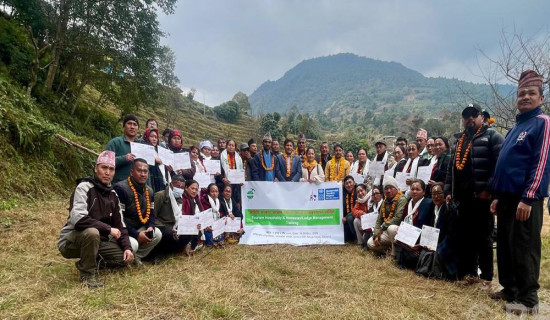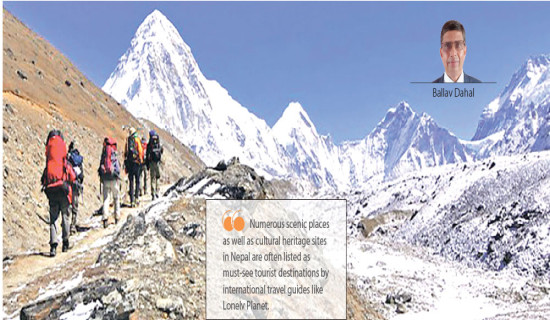- Sunday, 21 December 2025
Take Measures To Boost Tourism
Tourism is a vital force for creating jobs, spurring economic growth, preserving natural and cultural heritage and building peace in countries around the world. But this delicate sector has suffered an unprecedented setback following the outbreak of COVID-19 in late December 2019. Most nations had to impose travel bans and other restrictions to contain the pandemic.
It needs no reiteration that millions of jobs and sources of livelihoods were lost worldwide together with the outbreak of this contagion. The aviation sector alone incurred a loss of billions of dollars globally with most passenger flights coming to a grinding halt due to travel restrictions. Even many reputed airlines went bankrupt globally. The resurgence of newer variants of the pandemic led nations to partial or full lockdowns one after another. That caused further damage to the vulnerable tourism industry.
Recovery trend
However, global tourism seems to be rebounding steadily following the vaccination campaign against the pandemic. International tourism continued its recovery in January 2022, with a much better performance compared to the weak start to 2021, according to the World Tourism Organisation (UNWTO).
Global tourist arrivals more than doubled in January 2022 as compared to 2021. About 18 million more visitors were recorded worldwide in the first month this year. This equals the total increase for the whole of 2021. Global tourism needs to continue recovering to reach the pre-pandemic levels in tourist arrivals. However, given the successful inoculation against COVID-19 and drastic fall in infections and fatalities worldwide, international tourism is expected to continue its gradual recovery in 2022. Many destinations from around the world have already lifted COVID-related restrictions while others have eased such curbs.
But the ongoing Russia-Ukraine war has become an obstacle to the global tourism recovery because it has added pressure to existing economic uncertainties at a time when several COVID-related travel restrictions are still in place. Since the war does not appear to be coming to an end anytime soon, it could affect overall confidence and impede the process of tourism revival. The pandemic dealt a fatal blow to Nepal’s tourism as well. Hotels, restaurants, airlines and other sectors associated with the tourism industry had to go through the worst period in history. Hundreds of thousands of people involved in tourism business became jobless and tourism receipts shrank considerably drastic a drastic drop in international tourist arrivals.
In 2019, Nepal hosted about 1.19 million international tourists. Such a remarkable rise in tourist arrivals had created a lot of rays of hope among the travel trade people and government authorities. Nepal was to organise Visit Nepal Year 2020 with a target of bringing in two million foreign tourists by that year. But no sooner had that key national tourism campaign kicked off than the global public health emergency broke out, causing the most unfavourable situation.
In 2020, the nation saw only 230,085 foreign tourists. In 2021, the figure dropped further to 150,962. However, the country’s tourism has begun bouncing back gradually since the beginning of 2022. About 16,975 foreign tourists entered the nation in January while the number increased to 19,766 and 43,600 in February and March, respectively. In April, the country welcomed more than 58,300 foreign tourists. These figures speak volumes that the country’s tourism has now been on a strong recovery track.
Nepal has welcomed a lot of mountaineers this spring. More than 700 climbers from as many as 70 nations from across the world have received permits to attempt various mountains, including Sagarmatha. The government receives a lot of revenue in royalties from these expeditions. Besides, mountain guides and other support staff have got a seasonal employment. As expedition members stay within the country for longer period as compared to other visitors, their spending is much higher than others. They are the ones to directly support the rural economy.
In Nepal, tourism is regarded as the second largest source of foreign exchange earnings after the remittance sector. In view of tourism’s contribution to job creation and maintaining foreign currency reserves, the government has given top priority to this sector. In an effort to revive the tourism industry, the government had constituted a National Tourism Recovery Directive Committee some four months back under the leadership of Minister for Culture, Tourism and Civil Aviation Prem Bahadur Ale. A technical panel under that committee had also been formed.
Having assessed the overall scenario, the technical committee has lately submitted its report to the concerned ministry. The report suggests taking necessary measures to revive the ailing tourism business. The technical panel advises the government to work towards attracting a total of 500,000 foreign tourists into the country this year and one million in 2023. It has also proposed for rebranding Nepal as an appealing tourist destination. It has recommended for conducting skill development training and exploring new tourist spots in all the seven provinces to diversify tourism.
Need of promotion
Since tourism investments worth billions of rupees have gone down the drain in the country since the appearance of COVID-19, it is necessary for the government to come up with a prompt initiative to build confidence among the investors. Nepal has now become a safer destination for tourists with more than 70 of eligible population receiving a jab. As suggested by the technical committee, it is time for the country to focus on international publicity and promotion to give a boost to the tumultuous tourism industry.
(Dahal is a deputy executive editor in this daily.)

















